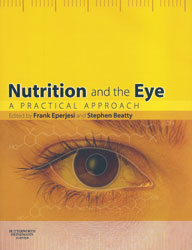Optician's clinical editor, Bill Harvey, and Professor Robert Fletcher (below) look at two books regarding nutrition and the eye
Nutrition and the Eye : A Practical Approach On seeing that this book was now finally available, my first response was 'at last!' Many patients now ask for advice on nutrition, having read various sources making claims about the influence of nutrition upon eye health.
On seeing that this book was now finally available, my first response was 'at last!' Many patients now ask for advice on nutrition, having read various sources making claims about the influence of nutrition upon eye health.
While some are aware that a good diet is helpful in maintaining some aspects of eye health, too many often misinterpret some of the marketing literature available, and often assume that certain vitamin tablets will 'make my eyes better' or, worse, 'can cure my macular degeneration'.
This comprehensive book takes an objective look at the influence of nutrition upon the eye and the research that has made our understanding of the complex interaction between diet and health. It is well-referenced and, importantly, offers information in a clear and unbiased way.
The sections are colour-coded and sensibly split. All eye care practitioners will find the initial section on nutrition science valuable as it offers a wealth of information on nutrition science, absorption factors, measures of nutrition and a clarification of the often confused terminology used in nutrition-related literature.
The next section offers a very comprehensive review of the various nutritional components, such as carotenoids, lipids and minerals, and how they influence the eye. The section ends with a very clearly written summary of the effects of oxidative stress upon ocular tissues.
After a brief but interesting look at retinitis pigmentosa and two vitamin deficiencies, there is an excellent and extensive section on the ageing eye which is where the book comes into its own. Anyone having read this should be well armed to offer good fact-based advice to a patient interested in better understanding what sort of nutritional influences upon the eye exist. Initially, I was disappointed that there was no related appendix summarising best advice to patient. The book, though, does leave it open for every practitioner to tailor such a fact sheet to their individual practice profile based on the information offered here.
Towards the end, there are two chapters detailing the research projects each author is involved with. As neither study is completed, these whet one's appetite for future findings, serving as a useful indication of research design for students.
I wholeheartedly recommend this text to anyone working in the low vision arena, where issues relating to nutrition and particularly AMD are a constant feature. However, all in practice should find much of value to allow them, not only to advise patients, but to read with greater objectivity some of the claims from various commercial and popular media sources with which they are bombarded.
Nutrition and the Eye - a Practical Approach. Edited by Frank Eperjesi and Stephen Beatty. Elsevier Butterworth-Heinemann. ISBN 0-7506-8816-5, 280pp. £39.99.
Register now to continue reading
Thank you for visiting Optician Online. Register now to access up to 10 news and opinion articles a month.
Register
Already have an account? Sign in here
